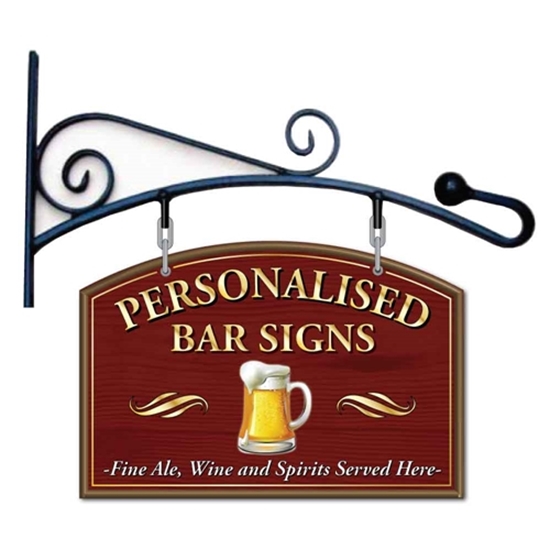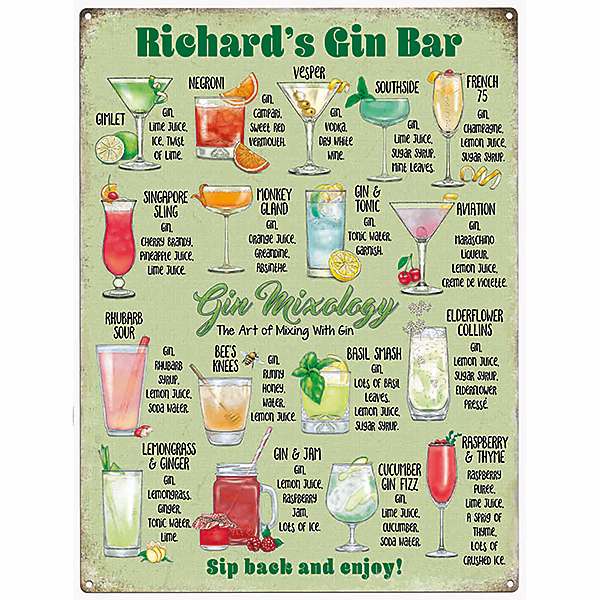Good Suggestions To Picking Gin Bar Signs
Wiki Article
What Is The Difference Between Bar Signs In Size?
The dimensions of bar signs vary depending on the intended purpose as well as their location and general design aesthetic. Here's a look at the impact of size differences on the effectiveness and appeal of bar signs:1. Large Signs
Attract attention and provide a focal place.
Uses External branding, main brand signs, or feature wall.
Placement: These are usually placed on walls or large areas outside the bar, to attract customers.
Examples include large neon signs or oversized vintage style signs, or expansive wall-type signs.
2. Medium Signs
The goal is to add information, or enhance the decor without taking up too much space.
Uses for: Signs for directional signage, menu boards, as well as promotional display.
Placement of signage: Ensure that the signage is visible however it is not overpowering.
Signs with decorative designs or metal signs to promote your bar.
3. Small Signs
Purpose: Add subtle decorative elements or provide specific information.
Uses : Table signs decorative objects, labels, etc.
Placement: Displays and tables that are close to the viewer.
For example, table numbers signs, tiny framed quotes, or drink menus.
Size Aspects
Visibility
Large Signs: They're designed to be visible from far away, making ideal to attract pedestrians and establishing a bar's presence.
Medium signs: Delivers vital information in a space-efficient manner and without obstructing the design.
Small Signs are best for providing information with close proximity and intimate details. This will enhance the user experience.
Proportion
Large Signs: They should be proportionately big to avoid overwhelming smaller spaces. Ideal for open or spacious environments.
Medium Signs: These signs are suitable for use in various interior areas. They can be placed in various ways.
Small signs: Ideal for adding detailed details and fitting into smaller spaces without cluttering.
Impact
Signs that are large can create an impressive statement. they are also used as branding elements. It is commonly used to create a mood for a bar.
Medium Signs Creates a balance between design and visibility, contributing to the overall atmosphere while conveying important information.
Small signs: They bring charm and depth to the visual experience, while also enhancing the experience.
Practicality
Due to their size, large signs could be costly.
Medium Signs are more flexible when it comes to design and are easier to install.
Small Signs: Very versatile and easy to update or replace suitable for dynamic environments like bars that change menus or promotions.
Functionality
Large Signs: Mostly for visibility and attraction.
Medium Signs are both functional and also decorative. They provide vital information as well as enhance the visual appeal.
Small signs: They are mostly functional, providing specific details. They contribute to the overall design of the space in a subtle fashion.
The best size for bar signs will be contingent on the purpose of the sign, its location within the bar, and how it is perceived by patrons. By balancing these factors, you can ensure that the signs are effective to the atmosphere of the bar and the operational needs. See the most popular hanging pub signs for blog tips including personalised home bar signs, outdoor personalised bar sign, bar signs for garden, personalised sign for bar, personalised metal pub signs, personalised cocktail sign, outdoor home bar signs, pub sign hanging, personalised sign for bar, bar signs for home and more.

What Are The Differences Between Bar Signs With Regard To Installation And Mounting?
Bar signs differ in regards to the method of installation and mounting depending on their style and weight, size, location, and intended purpose. This article will provide a more detailed review of bar sign mounting and installing methods: The wall-mounted sign
Directly fixing to the wall.
Methods:
Anchors and screws are used to secure heavier signs (metal or wood).
Adhesive Tape: It can be applied to signs with a lighter weight like foam board or acrylic.
Brackets are used to increase the visibility of signs by allowing them to protrude beyond the wall.
Uses: Indoor decor, menu boards, directional signs.
Advantages: Easily adjustable, secure, and prominent display.
Walls are not ideal: They can become damaged and it can be difficult to move the product.
2. Hanging Signs
Suspended or hung from ceilings.
Methods:
Chains: strong and flexible, perfect for heavy signs.
Cables: A sleeker appearance that is frequently employed in contemporary designs.
Rods: Provide a rigid support structure.
Uses: Ceiling decor, directional signs, overhead promotional signs.
The vertical space is highly visible and the decorative options are endless.
Negatives
3. Freestanding Signs
Specifications of the product The stand isn't fixed to anything.
Methods:
A-Frame is foldable and portable often used to promote on sidewalks.
Pedestal Stands: Stable base, ideal for indoor use.
Post and Panels: Usually used to create permanent or bigger signs.
Uses: Outdoor advertising, indoor directional signs, promotional displays.
Features This product is lightweight, versatile and easy to position.
Cons: It is bulky and requires floor space.
4. Window Signs
Characteristics: Attached straight to windows.
Methods:
Suction cups are easy to install and removal, suitable for signs with smaller sizes.
Adhesive Vinyl: Applied directly onto the glass, it is ideal for graphics and decals.
Static Cling Permanent but not permanent. Reusable. It is easy to apply and take off.
Examples of uses include: advertising messages or branding, as well as the hours of operation.
Benefits: Increases the amount of window space. Visible from the outside.
Limitations: Could be affected by sunlight and is and is limited by the dimensions of your window.
5. Backlit Signs and Edge-Lit Signs
Signs that have lighting are essential.
Methods:
Wall Installation with Electrical Connections It requires a secure attachment and electrical hook-ups.
Suspended by Power Cables Hanging technique is combined and integrated lighting.
Examples include high-visibility branding for menu boards or decorative elements.
The benefits include increased visibility and attractive illumination.
Negatives: Requires electrical wiring and more complicated installation.
6. Portable and Temporary Signs
Specifications: It is designed to be easy to put up and to take down.
Methods:
Pop-up Stands: Light and compact.
Banner Stands: Roll-up or retractable designs.
Examples include events, promotions, seasonal decorations.
Benefits: Easy transportation, rapid set-up.
Advantages : less durable and could not last as long.
7. Magnetic Signs
The characteristics of this product are that it is attached with magnetic force.
Methods:
Magnet Strips: These are glued on the back of the sign.
Magnetic Boards: Signs that attach to metallic surfaces.
Uses: Menu boards with a changeable layout, temporary notices.
Benefits: Easy to set up and take down and no permanent fixtures are required.
Disadvantages: Limited to magnetic surfaces, it can be less secure.
8. Projection Signs
Use light to project a image or text.
Methods:
Mounted projectors can be mounted on ceilings or walls.
Portable Projectors : Positioned either on stands or on other surfaces.
Examples include dynamic displays promotions, events, and displays.
Advantages: No requirement to buy a physical sign, as the content can be easily changed.
Negatives
Take into consideration when mounting and assembling
Size and weight
Heavy Signs need stronger mounting solutions, such as screws or anchors.
Light Signs can be created with less complex methods, such as suction cups or adhesive strips.
Durability
Permanent Signs: Use an easier and more durable method of mounting.
Temporary signage: Use methods that make it easy to move and reposition the sign.
Location
Indoor: More flexibility in the use of materials and methods, with less concern about weather.
Outdoor: Must be made of weatherproof materials and secure mounting that can stand up to the elements.
Aesthetics
Concealed Mounting: Provides the appearance of a neat design by hiding hardware.
Decorate with decorative hardware: Improves the look of a sign.
Accessibility
Access to updates easily Access to changes is essential for signs like menu boards which require regular changes.
Security: Ensures the signs aren't easily altered with or stolen.
Bar owners must consider these factors to choose the most suitable mounting and installation method that meets their requirements. This will ensure their signs are easily visible, safe and will meet their aesthetic as well as functional requirements. Read the best personalised bar signs hints for more recommendations including home garden bar signs, pub sign design ideas, novelty bar signs, bespoke bar signs, bar sign hanging, personalised metal pub signs, pub signs personalised, garden bar sign personalised, staying inn sign, large bar signs and more.

How Do Bar Signs Are Kept Up To Date?
There are a variety of ways that bar signs differ in terms of maintenance requirements. Here are some examples of how bar signs can vary in their maintenance requirements:1. Materials
Metal signs generally need minimal maintenance, occasional cleaning may be needed to get rid of dirt or other debris.
Wooden Signs (Signs): These require regular inspections for signs of rot or warping. Periodic staining may be necessary to preserve the quality and appearance.
Acrylic Signs are easy to clean using water and mild soap Resistant to the most chemical and scratches.
Neon/LED Signs require a regular bulb replacement, and also the examination of electrical parts. This is especially true for signs that are used outdoors.
2. Lighting
Non-illuminated Message Signs The signs are low maintenance but may require periodic cleaning to get rid of dirt and dust.
Illuminated signs (Neon/LEDs): These need periodic inspections of light components, such as bulbs or LED modules, and also cleaning diffusers or lenses to ensure visibility and brightness.
3. Location
Indoor Signs need less maintenance since they are protected from the elements.
Outdoor Signs: These signs require regular maintenance because they are exposed to extreme weather conditions, UV rays and temperature fluctuations. It may be necessary to apply protective coatings and perform regular inspections in order to prevent the signs from deteriorating.
4. Design Complexity
Simple Signs. Designs with less components that require less maintenance than more complex designs.
Digital Signs: They require software updates, changes in content, and technical maintenance periodically to ensure they are operating properly.
5. Installation and Mounting
A properly erected sign is less likely to require maintenance as it will not shift or become loose over time.
Poorly Mounted Signs: Signs that have been poorly mounted or are installed may need more frequent maintenance due to problems like sagging, inclining or the detachment.
6. Environmental Factors
Weather Exposure: Signs in areas with high humidity, such as extreme temperatures or rainfall might require regular maintenance. This is in order to prevent corrosion or fading.
Pollution and debris : Signs in urban and industrial areas may accumulate dust and dirt. They must be cleaned regularly to maintain their visibility and appearance.
7. Customization
Custom Signs: Signs with intricate designs, custom finishes, or distinctive characteristics may require special maintenance procedures to preserve their design and function.
8. Frequency
Regular Maintenance - Creating a regular schedule for cleaning, inspections and maintenance will help prevent minor issues from becoming more serious and ensures that signs are in optimal condition.
Signs require maintenance when needed. This is done to repair specific problems such as damage, wear or malfunction.
The Benefits of Regular Maintenance
Longer life span. Regular maintenance is a great way to prolong the lifespan of your signage and reduce the need for replacement before it is needed.
Optimal Performance: Well-maintained signs ensure their readability, visibility and efficiency in communicating messages to customers.
Cost savings: Regular maintenance helps to avoid costly repairs or replaces later, thereby saving money in the end.
Bar owners can enhance the customer experience and general atmosphere of their establishment by recognizing and complying with the maintenance requirements of various bar signs. Read the top rated bar hanging sign examples for blog examples including signs for the bar, the staying inn pub sign, pub signs personalised, pub bar signs, pub bar signs, sign for garden bar, personalised outdoor bar signs, hanging tavern sign, personalised garden bar signs, hanging pub signs for garden and more.
